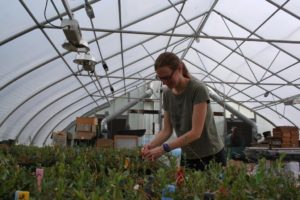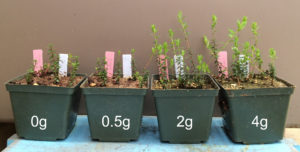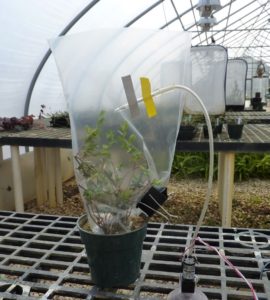Can you recall the smell of cut grass? Many plants, including cranberries, emit different smells, or volatiles, when damaged by cutting, but

Dr. Elvira de Lange in the greenhouse
also when damaged by herbivorous insects. These volatiles could then be used by predators to find prey, or by parasitoids to find hosts. However, fertilizer applications may affect emissions of these herbivore-induced volatiles, and therefore the interactions between plants, herbivores, and their natural enemies.
At the P.E. Marucci Blueberry & Cranberry Research Center, Drs. Elvira de Lange and Cesar Rodriguez-Saona studied the effects of fertilizer on volatile emissions in potted cranberry plants. They tested six cranberry varieties: Howes, Early Black, Potter, Stevens, Franklin, and Crimson Queen, exposed to four fertilizer regimes: 0, 0.5, 2, and 4 g NPK controlled-release fertilizer.
A previous study showed that increased fertilizer rates decreased resistance to herbivores. Three insect herbivores gained more weight on plants exposed to the higher fertilizer regimes, and also showed increased survival on these plants. Possibly, this was due to increased levels of nutrients and reduced levels of defensive compounds.

Fertilizer regimes
To test whether fertilizer also affects plant volatile emissions, we placed bags around potted cranberry plants, and using small pumps, sucked the air out of the bags. Connected to the pumps were trapping filters containing an adsorbent material, which was used to trap the volatiles. The results showed that higher fertilizer rates increased the total emission of volatiles, that is, the emission of all individual volatile compounds combined. This effect was found for all tested cranberry varieties, and was due to an increase in plant fresh weight. Indeed, higher fertilizer rates increased plant biomass substantially. Exposure to higher fertilizer rates also led to the emission of compounds that were not emitted when plants were exposed to lower fertilizer rates.
The effects of these increased volatile emissions, and changed volatile blends, on natural enemy attraction still need to be investigated. However, it is known that volatiles not only attract natural enemies, but they can also attract, as well as repel, insect pests. It is important to study possible changes in insect communities in response to fertilizer applications, to determine when and where to apply chemical and biological products for optimal pest control.

Volatile collection apparatus
In cranberry, previous studies by Dr. Cesar Rodriguez-Saona showed that plant volatiles affect the attraction of an herbivore, Sparganothis fruitworm; several predators, such as lacewings, ladybeetles, and hoverflies; and some parasitoid wasps. Potentially, volatiles could be used to manipulate pests and natural enemies in agro-ecosystems, directing natural enemies towards crops, while directing pests away from them. Therefore, adjusting volatile emissions, through select fertilizer applications, use of synthetic volatiles, selection of particular varieties, or otherwise, could contribute to integrated pest management programs in cranberry.
This study is published in Plant Signaling & Behavior: https://doi.org/10.1080/15592324.2019.1616517
We thank Rob Holdcraft, Vera Kyryczenko-Roth, and the summer students in 2015 for assistance with the experiments. Funding was provided by Hatch Project No. NJ08192 and the New Jersey Blueberry and Cranberry Research Council, Inc., Cranberry Institute, Cape Cod Cranberry Growers Association, Canadian Cranberry Growers Coalition, and Ocean Spray Cranberries, Inc.

